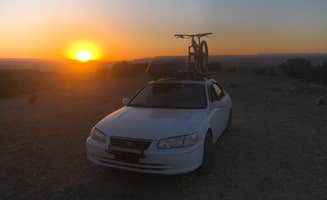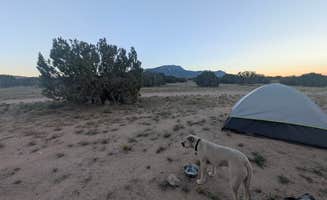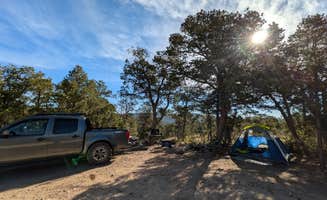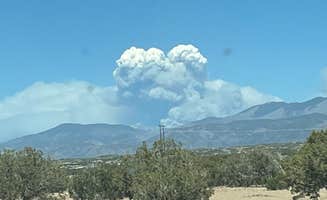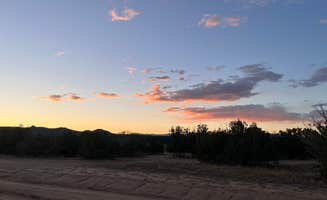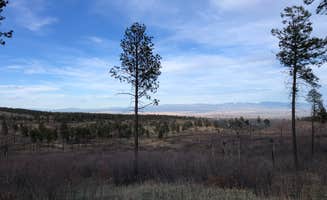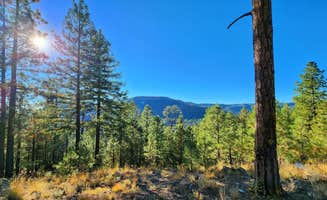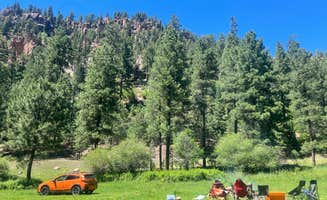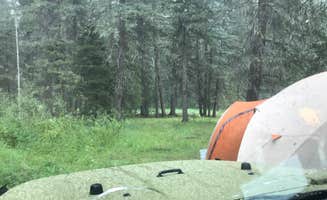Dispersed camping near Placitas, New Mexico typically occurs at elevations between 5,000-7,500 feet, creating significant temperature variations between day and night. The area sits at the northern edge of the Sandia Mountains where juniper and piñon pine dominate the landscape. Summer temperatures can reach 90°F during day while dropping to 50°F at night, with afternoon thunderstorms common from July through September.
What to do
Stargazing opportunities: Many sites around Placitas provide excellent dark sky viewing due to limited light pollution. At Top of New Mexico - Dispersed Site, campers can experience remarkable astronomy conditions. "This is a perfect hidden gem for campervanning... you can clearly see the Milky Way. No light pollution except the beautiful view of the city far away," notes Lauren I.
Wildlife observation: The region supports diverse wildlife including wild horses, elk, and various bird species. "My first morning I was surrounded by a group of 5 cows grazing. They ended up laying 30 feet from the trailer all morning," reports Josh F. from Top of New Mexico. Morning and evening hours offer the best viewing opportunities.
Off-road exploration: Multiple forest service roads provide access to remote areas suitable for ATVs and dirt bikes. At Santa Fe BLM Dispersed Campsite, visitors find "Lots of off road trails for dirt bikes and ATV," according to Shannon C. Trail maps are available from the Bureau of Land Management office in Albuquerque.
What campers like
Mountain views: The elevated terrain creates panoramic vistas across valleys and toward surrounding mountain ranges. At Dispersed Camping off FS 542, visitors enjoy significant elevation. "Altitude 7,200, rough road... This large spot was great for us," shares Lynn, highlighting the rewards of the climb.
Privacy and isolation: Despite proximity to Albuquerque, many sites offer seclusion. At Dispersed Camping off FS 542, one camper noted, "The area had great views and was very private. Will definitely visit again," according to Jose L. Sites farther from main roads typically provide the most isolation.
Cell service availability: Unlike many remote camping areas, several Placitas sites maintain usable cell connectivity. At Pajarito Springs (Dispersed), "Great Starlink location and pretty good cell service (3/4 bars)," reports Josh F. This allows for emergency communications and limited work capabilities while camping.
What you should know
Road conditions: Access routes to most dispersed sites require careful driving and appropriate vehicles. "The road up to the camping area is decent. There are big ruts headed into the camping area that are impassible to low clearance vehicles but nice spots otherwise," warns Jennifer M. about Manzanita Rec Zone Dispersed Camping.
Navigation challenges: GPS directions often lead to incorrect locations or private property. "Google/Apple directions should not be used, they take you to a locked gate," cautions Taz G. about Top of New Mexico. Rangers recommend using Forest Service maps rather than standard navigation apps.
Weather preparedness: The high elevation creates significant weather variations. "It can get very windy as well so watch out closely with your fire if you have one. Elevation is about 7500 feet so if you're from sea level like us, give yourself some time to acclimate," advises Ashley T. about Dispersed Camping off FS 542.
Tips for camping with families
Site selection priorities: Choose campsites with natural barriers and distance from hazards. "When you first arrive to the end of the road and the beginning of the public land - you have the option to go left, straight, or right. The straight route has the most options I found," recommends Josh F., describing the layout at Top of New Mexico.
Educational opportunities: Several sites offer chances to observe local wildlife responsibly. "Woke up in the morning to a heard of wild horses moving through the area," reports Taz G. at Top of New Mexico. Children can learn about local ecosystems while maintaining safe distances from wildlife.
Safety considerations: Prepare for variable conditions and limited emergency services. At Cedro 2 Track 13 Dispersed Site, campers appreciate that "We are the only ones here they have nice fire pits very quiet lots of trees. Because of that you have quite a decent wind block," notes Sherry M., highlighting how natural features can improve camping comfort.
Tips from RVers
Size limitations: Large RVs and trailers face significant challenges on most access roads. "The gravel roads are really tight for my 27" trailer, manageable but did rub on a couple of trees and shrubs on the drive in," explains Josh F. about Top of New Mexico. Class B and smaller trailers navigate most roads successfully.
Leveling requirements: Many sites feature uneven terrain requiring substantial leveling equipment. "We stayed one night here in our class c while on our trip to Miami and yeah the road is to be taken slow but it was worth it!" shares Lily C. about Top of New Mexico. Bringing extra leveling blocks is advisable.
Turnaround space: Limited turnaround areas create challenges for longer vehicles. "Mostly residential area until you get to the open space. I didn't make it to the actual coordinates as I took a wrong turn near the end, but there is a ton of open space out here. Easy to get to in 25' RV," reports Chris S. about Top of New Mexico.


